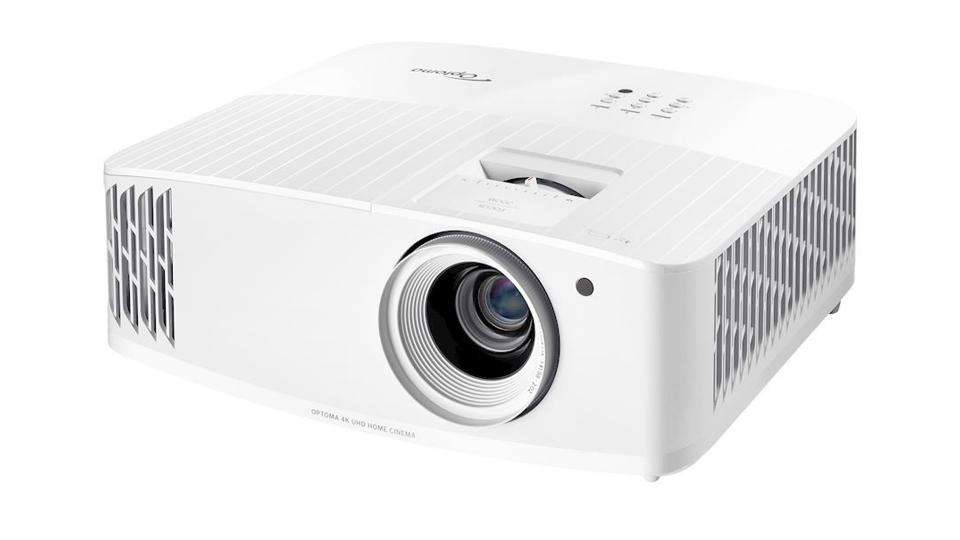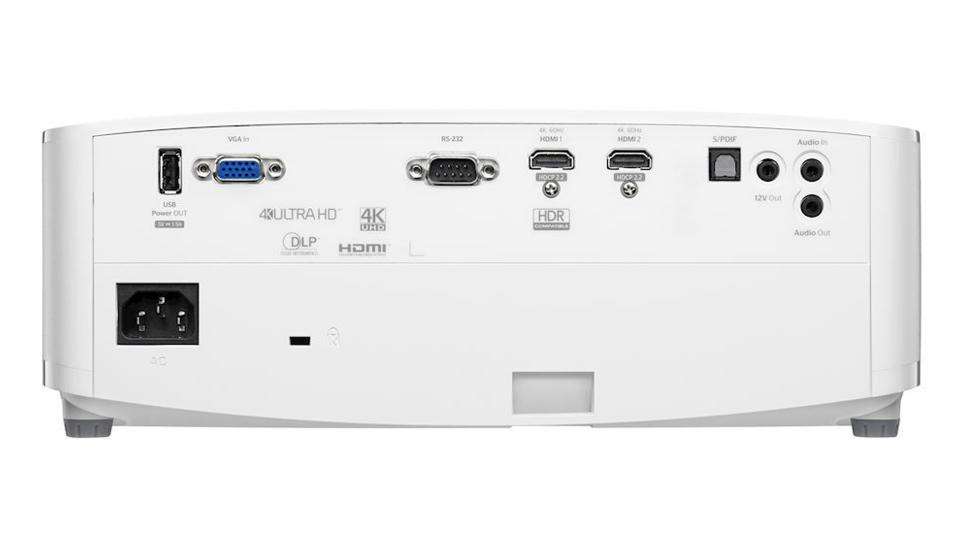The Optoma UHD38 is a low-cost 4K projector on a mission. Sure, it’s a capable home cinema projector with HDR support and everything you need to enjoy UHD Blu-ray and streaming services, but its real focus is on gaming, with features to minimise input lag and boost colour vibrancy and contrast.
If you’ve never played games on a projector, then you might not understand the point. TVs and monitors can give you higher HDR brightness levels, wider colour gamuts, better clarity and higher refresh rates. However, having spent a few evenings with the Optoma UHD38 – and with other projectors before it – I can tell you that nothing bar a VR headset beats a projector when it comes to immersion. Games should be bigger than life, and the UHD38 makes damn sure that they are.
Buy now from Amazon
Optoma UHD38 review: What you need to know
In theory, the UHD38 is a 4K, HDR projector, although in practice there are a few caveats. First, it doesn’t have a native 4K resolution, instead using Texas Instruments’ 0.47in DMD DLP chip to generate a 4K image from 1080p hardware via pixel shifting.
Each pixel on the chip changes position four times for each frame at 60fps, shifting very slightly between each update to create a new pixel on the screen. It isn’t quite “real” 4K, but it’s close enough that bodies such as the Consumer Technology Association don’t make a distinction.
As far as HDR goes, the UHD38 supports HDR10 and HLG and has an output of 4,000 lumens, which you might think would be more than enough for convincing HDR. However, by the time you’ve get those 4,000 lumens to the screen, and that screen reflects them back in the direction of your eyeballs, you’re getting way below the 600cd/m² required for a decent HDR image, let alone the 1,000cd/m² or more required for true HDR.

This is true of all consumer projectors and, while it tries its best with tone mapping and the levels of brightness and contrast on offer, the UHD38 can’t pull off miracles on this account.
Its real strength, however, is gaming. It will work with consoles or PCs at 4K/60Hz, 1080p/120Hz or even 1080p/240Hz if you have a PC fast enough to keep up. And, if you engage the Enhanced gaming mode, input lag drops to a thoroughly responsive 16.7, 8.9 and 4.2ms respectively. There’s also a Gaming mode in the Image Settings that boosts colour and contrast over the more natural Cinema mode, with rather pleasing results. You can have all this goodness with a screen size of up to 300 inches, and while I don’t have a screen that size to try it out, I can report that at 100 inches, games are just as jaw-dropping and absorbing as you could possibly hope for.
READ NEXT: The best gaming monitor to buy
Optoma UHD38 review: Price and competition
There aren’t many 4K projectors available for around £1,000. BenQ has the well-regarded TK800M for approximately £1,000 to £1,100, along with a new, more gaming-centric model, the TK700S Ti , for around £1,200.
Beyond that, you’re looking at £1,500 to £2,500 for the more serious, step-up 4K models, and north of £4,000 before you hit native 4K projectors from the likes of Sony. Within Optoma’s own line-up, you can step down to the less powerful 3,600-lumen UHD35 . You might think the UHD42 would sit above it in the range, but it’s older and has a lower spec in some areas, so can’t be considered a step up.
Unless you’re willing to spend another £200 or so, the Optoma UHD38’s biggest rivals aren’t other projectors, but big-screen TVs with gaming features such as HDMI 2.1 support, 120Hz playback and Variable Refresh Rate support.
The LG 65NANO866NA can now be found for under £1,000, while Samsung’s Q65 QLED models have strong gaming capabilities and give you plenty of screen for similar money. You won’t hit 100 inches (let alone 300), but you’ll get more detail and more impressive, impactful HDR.

Optoma UHD38 review: Design
Optoma has evolved its physical design over the last generation or so, moving from the ribbed surfaces and open grills of the old UHD40 to an off-white box with cleaner lines, more decorative vents and a few more curves. The onboard controls are on the top, while all the connections sit at the rear. You’ll also notice that the foot at the front of the unit screws inwards and outwards to give you a little upwards tilt.
There’s a manual focus ring on the lens along with a zoom lever on the top, although this doesn’t give you a huge amount of flexibility, as it offers a mere 1.1x of zoom at its maximum range. With a 1.5:1 throw ratio, the Optoma isn’t exactly what you’d call a short throw projector, so you need a bit of space to get the most from it. For a 100in 16:9 image, for instance, you’ll need around 3.3m to play with. If you can only find 2m, you’re looking at a measly 60in screen.
What’s more, it isn’t the most convenient projector when it comes to positioning. You can place it on a table or mount it on the ceiling, while rear-projection is an option. However, you’re limited to basic horizontal and vertical keystone correction rather than any kind of image-shift adjustment, plus one of those notoriously fiddly corner adjustments which always seem to correct one issue while causing another.

In terms of connectivity, the UHD38 gives you everything you need bar a DisplayPort input. For video, there’s an old-school VGA input plus two HDMI 2.0 ports, both supporting 4K/60 or 1080p at up to 120Hz. That means no 4K at 120Hz through HDMI 2.1, although I suspect that’s beyond the TI DLP chip in any case. For audio, meanwhile, you have an S/PDIF output plus a 3.5mm line-in and matching line-out.
There’s no Bluetooth audio as you get with some projectors, but it’s probably safe to assume that most users will either have a full surround speaker setup or at least a soundbar, and you can usually get some kind of wireless headphone audio directly from your console or media device.
READ NEXT: The best gaming headset for consoles
Optoma UHD38 review: Picture quality
Let’s get the gripes straight out of the way. If you’re looking for a projector for home cinema or general entertainment, the UHD38 isn’t the best we’ve seen. Don’t get me wrong; it’s still very good. You wouldn’t really know that it isn’t native 4K because its pictures have superb definition and come crammed with detail. Colours are extremely rich and vibrant but not over-pushed or unnatural looking, particularly if you stick to the Cinema preset.
There are, however, three problems. First, while it’s bright, you need to be realistic about HDR content. Watching 4K HDR Blu-rays and Disney+ video streams, you can see that there are HDR effects in place, but the colours and highlights don’t zing in the way they do on a good HDR TV. To be honest, that’s something that’s common to all consumer projectors.
Black levels are another matter. Even the UHD38’s deepest black looks grey-ish, and the lowest black luminance level I measured was 2.79cd/m². Combine that with the relatively limited brightness of the projected image – around 255cd/m² when measured 30cm from the screen – and you’re not going to get the kind of shadow detail or dynamic range that you might see on more expensive 4K projectors, not to mention a good UHD TV.
You can push the brightness up beyond this, of course, and the projector even has a special Bright mode. However, the higher you go, the worse the black level becomes and the more the colour drifts, amplifying some rather pushy greens into something approaching a tint.
But here’s the good news: as long as you can accept the limited HDR capabilities and the fact that space doesn’t look inky black, the opening space battle from a 4K Blu-ray of Star Wars: Episode 8 – The Last Jedi still looks fantastic.
The laser cannon fire and explosions paint the screen with energy and colour, and you’re soon too absorbed to fuss about any shortcomings. It was a similar scenario with scenes from the mighty Thor: Ragnarok on Disney+, not to mention The Incredibles and Star Wars: The Bad Batch . Ignore the black level and there’s plenty of detail, drama and excitement. Dynamic range matters, but size still means a lot.
And these issues fade away even further once you start playing games on this thing. I kicked off with a series of Xbox One X favourites, including Halo 5: Guardians and Doom (2016), and there’s something bold and epic about the UHD38’s presentation that drags you, kicking and screaming, into the Master Chief’s epic odyssey, Mars or the depths of Hell. There’s enough shadow detail to see what’s happening in dark corners, while the rich and vibrant colours contribute to some spectacular action. The handling of HDR colours and highlights seems more confident and assured, too.
Switch to a next-gen console and things only get better. There’s enough definition and dynamic range to make the likes of Ratchet and Clank: Rift Apart and Call of Duty: Black Ops – Cold War look fantastic, and the 1080p/120fps option on the latter is beautifully fluid, without a hint of lag, jerky panning or stutter with the Enhanced Gaming mode turned on. I was also able to get DiRT5 running at 1080p/120 on the Xbox Series S, and Codemasters’ under-rated off-road racer was incredibly fluid.
I was also surprised to find that the UHD38’s brightness levels make it usable during the day. In a bright room you’ll lose some of the colour and contrast, but you don’t have to wait until the sun has headed over the horizon or close every curtain just to get a watchable image. However, the Eco mode is probably worth avoiding if you want to get the best in either light or dark situations, as the image gets noticeably dimmer and less contrast-rich.
Eco mode will take the lamp life from 4,000 hours up to 10,000, but is it a compromise too far? Well, yes. The only worry is that if you’re a serious five-hours-a-night gamer, you might burn through that lamp within two or three years.
READ NEXT: The best Nintendo Switch controller
Optoma UHD38 review: Verdict
The UHD38 is a good home cinema projector with rather underwhelming black levels, but it’s a great projector if you’re into gaming. It will do 4K/60 on your Xbox Series X or PS5, or 1080p/120 if you value high refresh rates over resolution, and it will do it with virtually no significant input lag.
And while you’ll find TVs at the same price with better connectivity, more contrast or stronger HDR, it’s worth accepting a few trade-offs just to play on a massive screen. Gaming just doesn’t get more epic than this.












